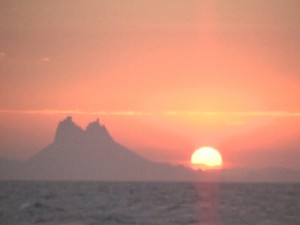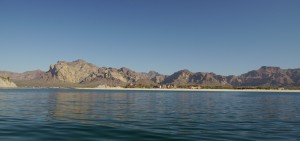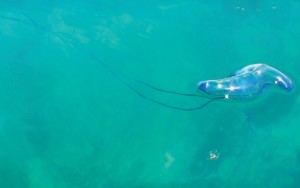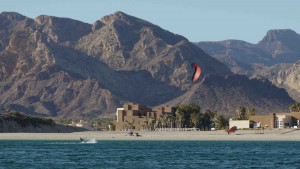Page is under Construction
San Carlos 27° 55′ N
111° 03′ W
Well San Carlos is my home turf and I have lived here full time for 23 years now so here goes. San Carlos is located in the mid gulf region of the Sea of Cortes about 245 miles

south of Nogales and 325 miles from Tucson Arizona. With its close proximity to the border, dozens of great anchorages, multitude of ship yards and 3 marinas all combine to make this an almost perfect destination for cruisers.
Anchorages: Check the google map above for the myriad of places to drop the hook. Anchorages described below will start at Algodenes bay and then move west towards San Franciscito bay and Guaymas.

Bahia Algodones: Algodones bay is the second largest bay just north of the famous Teta Kawi mountain. Bahia Algodones is formed by Isla Venado on the west and Punta San Antonio to the East. Both excellent scuba diving & snorkeling spots. Looking due north this anchorage provides you with spectacular views of the La Sierra del Aquaje or in english, the wet mountains. Bahia Algodones provides great protection from the predominately north westerly winds of
winter to the southerly jelly fish ridden winds of summer. Anchor tucked up to the islands in front of the Paradiso hotel (the old Club Med) during winter. There are two bars located on the western side of the bay, Bonafacios Cotton Club & The Soggy Peso both offer food and beverages and live music on the weekends. The San Carlos Plaza and Marina Real are located on the eastern side of the bay. During October and November when you will be dropping the hook on the eastern side of the bay you will most likely observe several wedding’s going on since this is traditionally wedding season in Sonora and love is truly in the Air. Que Romantico!

In summer the calmest anchorages are found on the east side of the bay from San Antonio point to the Marina Real. In summer watch out for the Jelly’s dude, those being the Portuguese Man of War, Aqua Malas (bad water) in spanish. These strong stinging and potentially dangerous species represent a rather special kind of jelly fish called siphonophores. Not a true jelly fish due to the fact that these animals do not undulate but passively float on the surface of the water and are nothing more than slaves to wind and current. Slaves that they be though they can still sting the living you know what out of you so watch it! May to October is the season but typically the middle of the summer is the worst time of the year, especially after a rain and or a strong southerly wind has blown. You can even be stung by free floating tentacles in the surf or by actually pulling up an anchor with tentacles that have attached to the road of the anchor. I have even been stung by detached tentacles while helping scuba divers take off their BCD’s after a dive. Be extremely carful swiming around in the surf at night during summer. Always examine the beach at the high tide mark for signs of jelly fish. You will see their bodies there.
You can drop the hook in good holding sand and or rock in shallow water on any side of the bay. The only time I have every skipped anchor their was in the heart of winter when I dropped the 35 pound CQR on a patch of Sargasso sea weed which stopped the plow from digging in. I had to simply retrieve the anchor clear off the Sargasso and drop the hook once more. There are no real hazards in bay except that if you approach in the evening be careful of the rocks clearly awash just east of the south point of Isla Venado. See google map above. There is also one rock that is just north of Punta San Antionio that could be a potential hazard if you venture to close to the coast while anchoring there to snorkel or dive. Prudent skippers will never have problem with either of these hazards but I have known a few boaters over the years to accidently run into these two hazards. Alcohol and machismo was a contributing factor!

in front of Sierra del Aguaje Mountains
Algodones bay is also the hot spot for world class kite boarding and with the increased popularity of the sport it is not uncommon to see dozens of kite boarders sailing the perfect 15 to 25 knot side shore winds that blow consistently starting in October and ending around April. The small bay of La Manga is located just on the other side of the western point and is a great wave sailing spot although most kite surfers stay in the flatter water of Algodones. The bay at La Manga also has one of the best sea food restaurants in the area there. Dona Rositas Mirador de La Manga is well worth a visit and is an easy dingy ride or kayak trip or walk from Alogodones Bay. In strong Southerly winds you can anchor right in front of Dona Rosita’s restuarant and if wind is from the south you can anchor in front of the entrance to the laguna at hotel Paradiso.
Piedras Pintas / Mirador: Located almost directly under, slightly west of the Teta Kawi mountain this gem of an anchorage is a great spot for cruisers who wish to hike to the top of the Teta Kawi. There is also an OXXO connivence store located on the highway perhaps 3/4 of a mile from the anchorage. This is a excellent winter time northwesterly wind anchorage. Excellent snorkeling and diving can also be found here and which to this day still make piedras pintas the most preferred beach dive in San Carlos. There are two coves to anchor in. I invariable always anchor in the northernmost cove. This beach is often reffered to as Zorro beach since the first Antonio Banderas Zorro movie was filmed here. If you wish to hike the Teta Kawi for superb views of the coast and mountains then this is your spot. The most popular trail heads starts at the eastern most beach parking lot. It is impossible to miss the trail head and certainly no visit to San Carlos is complete without a trip up the mountain!
The Aquarium/Martini Cove: The Aquarium is the most anchored spot in Bahia San Franciscito and on any given day several charter and or private boats will be here. This great snorkeling dive spot is just inside the point at Punta Doble and is an excellent winter time anchorage but beware in summer. Changing tides and southerly swells can fill the small area with Portuguese man of war jelly fish with frightening speed. Kayak to the large caves at Punta Doble or hike to the point with splendid views of the bay. This small peninsula is the southern point that forms Bahia San Franciscito. Because of Punta Doble you have excellent flat water sailing in the bay during northwesterly winds. The area should be a Mexican national park or ANP, (Area Natural Protegido). As of this writing 2013 the area holds no formal protection what so ever and I do not doubt that land developers would be drueling at the chance to develop this virgin stretch of Sonoran coast line that has never seen not a single cow graze on it and thus has remained virtually untouched by the hand of man for millenniums.
La Bahia: La Bahia is where you will find the majority of cruisers anchored and moored. Personally I do not like anchoring in the bay for a multitude of reasons. Poor holding in some spots and howling winds in winter are two of the best reasons for dropping the hook some where else. What is nice about the bay though is the close proximity to the marina San Carlos the many good restaurants in the area with free Wifi and the dingy dock for landing’s. This advantage is often offset by the amount thievery that goes on in the bay. Do not leave valuable items on your boat for long periods of time here unguarded or you will eventually be the victim of a robbery. Especially out board engines and dingy’s. I even recommend locking your dingy to the dock while you are in town. There is a marine chandlery located at the marina.
La Posada Beach: This spot just east of the entrance to La Bahia is becoming an increasingly popular anchorage for cruisers in winter. The spot is very calm in a north westerly wind and the hills just west of the spot give better protection from wind than La Bahia. Another big advantage here is the fact that you can anchor your boat close to the beach land your dingy and walk up the arroyo to the brand new super market Santa Fe. Thus making re provisioning of the boat a pretty fast and relatively painless endeavor!
Isla Raza/Honeymoon Island: Honeymoon island over the last several years had become a brown pelican roosting area. Many many birds now inhabit the island so take great care if you should anchor here and land on the small beach at the north point. Western Gulls often make their nests right on the beach and I have seen chicks recently hatched plodding around the beach so be careful when you land. Also in spring time don’t scare brown pelicans off of their nests. Sea Gulls will swoop down at the first chance they get and kill pelican chicks and eggs. Be careful of the san bar off the north point of this small island as well. It extends a far distance from the beach. There is also a rpcl hazard located right in front of the restaurant Charlies Rock. Often there is a yellow buoy that marks the hazard but at this moment the buoy was pushed ashore by our last hurricane of the 2012 season so the marker is no longer there. The rock is closer to the coast than the island. I will have the GPS coordinate for it posted soon. If simply stay right in the middle of the channel between the coast and Honeymoon you will miss the rock.
